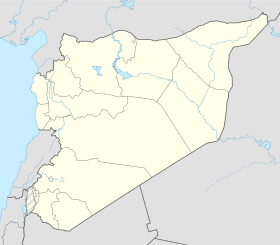Ain Dara (archaeological site)

The remains of the Ain Dara temple
|
|
| Location | Ain Dara village, northwest of Aleppo, Syria |
|---|---|
| Coordinates | 36°27′33.7″N 36°51′7.5″E / 36.459361°N 36.852083°ECoordinates: 36°27′33.7″N 36°51′7.5″E / 36.459361°N 36.852083°E |
| Type | Temple |
| Part of | Acropolis |
| Length | 30 m (98 ft) |
| Width | 20 m (66 ft) |
| Area | 600 m2 (6,500 sq ft) |
| History | |
| Material | stone |
| Founded | c. 1300 BC to 740 BC |
| Periods | Iron Age |
| Cultures | Syro-Hittite |
| Site notes | |
| Excavation dates | 1980–1985 |
| Condition | ruins |
| Public access | Yes |
The Ain Dara temple, located near the village of Ain Dara, northwest of Aleppo, Syria, is an Iron Age Syro-Hittite temple noted for its similarities to Solomon's Temple, also known as the First Temple, as described in the Hebrew Bible. According to the excavator Ali Abu Assaf, it was in existence from 1300 BC until 740 BC and remained "basically the same" during the period of the Solomonic Temple's construction (1000 - 900 BC) as it had been before, so that it predates the Solomonic Temple. The temples of Emar, Munbaqa, and Ebla are also comparable. The surviving sculptures depict lions and sphinxes (comparable to the cherubim of the First Temple).
Massive footprints are carved into the floor; whether of gods or humans or animals is debatable. Also left to speculation is to whom the temple is dedicated. Ain Dara may have been devoted to Ishtar, goddess of fertility; or dedicated to the female goddess Astarte, or the deity Ba'al Hadad.
Ain Dara temple is located in north Syria, 67 kilometres (42 mi) northwest of Aleppo near the Syro-Turkish border. It was built on a terrace known as the "acropolis of the tell". The tell itself is precipitous-faced and overlooks the Afrin Valley. The area is divided in two parts, the main tell that is 25 m (82 ft) above the surrounding plain, and the lower acropolis which covers an area of 25 ha (60 acres).
Just east of the temple site is the modern-day village of Ain Dara.
The discovery of the temple was the result of a fortuitous finding of a colossal basalt lion in 1955. Excavations in 1956, 1962, and 1964 were conducted by Maurice Dunand and Feisal Seirafi; beginning in 1976, Ali Abu Assaf continued the work. He discovered the temple and inferred that it was built in three structural phases in the period from about 1300 BC to 740 BC. The first phase was from 1300 BC to 1000 BC, the second phase from 1000 BC to 900 BC, and third phase from 900 BC to 740 B.C.E. This was preceded by the Chalcolithic period during the fourth millennium BC, and the tell remained occupied until the Ottoman period (1517 -1917).
...
Wikipedia

